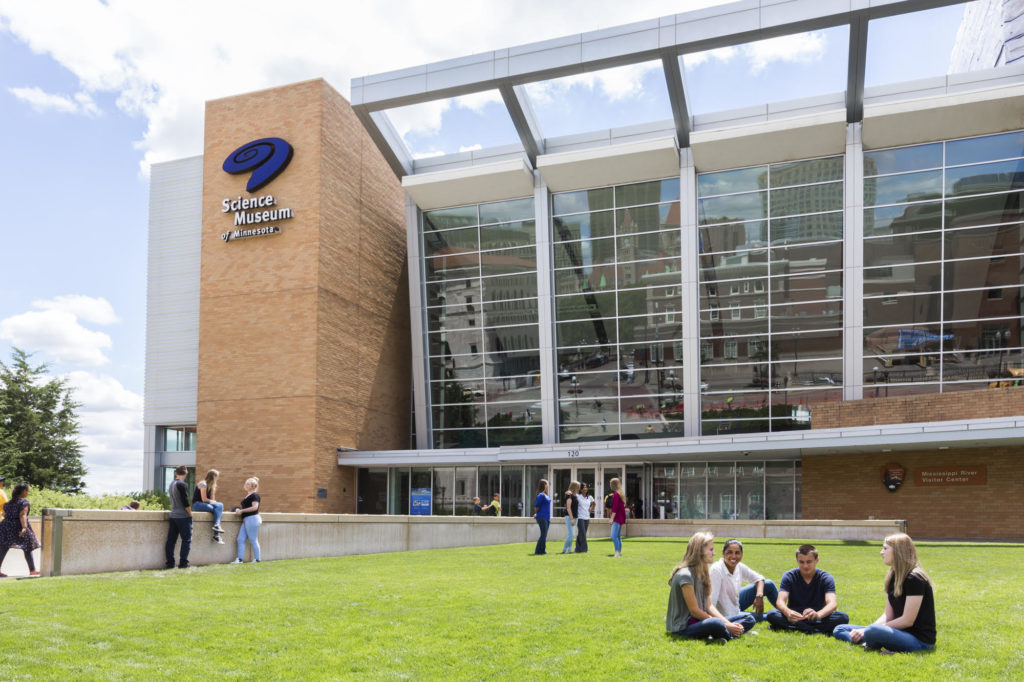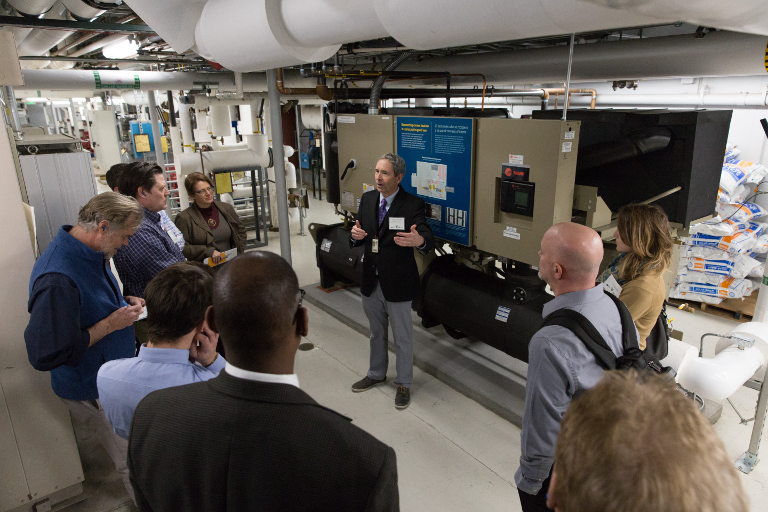Science Museum of Minnesota project demonstrates how Advanced Heat Recovery can curb global warming, and save money too
One of the important attractions at the Science Museum of Minnesota is hidden away deep in the interior of the building. Yet people still find it interesting and inspiring. Last year more than 200 engineers, building operation managers, environmental activists and other curious folk descended into the museum’s cavernous first floor mechanical room to witness a breakthrough technology that helps curb climate change while saving money and promoting green jobs.
At first glance, it’s not all that impressive. The Advanced Heat Recovery (AHR) system resembles a backyard grill crossed with a water heater, decked out with an enormous fuse box and pipes running here and there. It looks like something that might win top honors at a high school science fair for cooking 400 hotdogs at once.
What’s impressive is that it prevents about 1.8 million pounds of carbon dioxide from being released into the atmosphere each year, cutting the museum’s carbon footprint by 16 percent. This is significant in the fight against climate change, stresses Patrick Hamilton, the museum’s Director of Global Change Initiatives, because buildings account for one-third of US greenhouse gas emissions.
While grants covered the cost of the Science Museum project, Hamilton estimated that the system otherwise would have paid for itself in three years.
“We love that,” he said, “because it means we have $293,000 that can be redirected to the scientific and educational mission of the museum rather than to paying utility bills.”
What is Heat Recovery?
So, what’s the amazing technology that accomplishes all this? Two heat recovery chillers (think of very large versions of the heat pump in your refrigerator) capture excess heat produced by the museum’s lighting, electrical, and mechanical systems, which then is used to warm the building during colder months. The result is lower energy use, and that translates immediately into plummeting C02 emissions and smaller heat bills. Hamilton points out that the museum’s heating costs are down 65 percent since the AHR system became operational in March 2015. For instance, on a 4oF February morning, the museum was purchasing no heat from a local utility.
Here’s how it works. Heat generated by all the electricity used by the museum’s computer servers, elevator motors, telephone switching equipment and other big electricity loads is piped into the two heat recovery chillers rather than being rejected to the outside, as is standard procedure in most commercial buildings. Inside the chillers, compressors step up the heat energy to produce 115 oF water, which then is used to warm incoming fresh, cold winter air and circulated through radiators along the building’s extremities. It makes no sense at all for the Science Museum to purchase energy to heat the building while at the same time it discharges hot air to the outside.
“You don’t throw your aluminum in the garbage at home. You recycle it. So, you should recycle the heat in your building instead of throwing it away,” explains Matt Presser, account manager at Ingersoll-Rand, which manufactures the Trane chillers used at the Science Museum.
The museum embarked on this Advanced Heat Recovery project as part of its education mission. “This project proves you can save money and help protect the climate at the same time,” Hamilton declares.
“What was learned at the museum is that any building over 100,000 square feet can use this technology,” Spresser adds. “It’s a no-brainer for energy savings.” Regions Hospital in St. Paul, The Minneapolis Institute of Arts and Minneapolis College of Art & Design have all approached the Science Museum seeking more information about AHR.
Another AHR success story is the Evansville State Hospital in Indiana, where installation of heat recovery chillers manufactured by the Multistack firm reduced heating bills so dramatically the local gas utility sent out a technician to see if the meter was broken, according to Mark Platt, a manager for Trane speaking at a Science Museum green energy event.
“Ninety percent of commercial buildings could employ Advanced Heat Recovery systems right now—it’s a lost opportunity,” observes longtime energy consultant Dave Solberg, who helped pioneer the application of this technology at a Minnesota food processing plant and semiconductor factories and solar power equipment in Asia. In Solberg’s experience, building a new facility with AHR provides even more savings on operating costs than doing a retrofit like at the Science Museum. And AHR also substantially saves on construction costs by reducing the need for expensive heating, cooling and ventilation equipment and infrastructure, says Solberg, who recently joined Ingersoll-Rand.
AHR technology shows tremendous potential across the country for use in large facilities like office buildings, hospitals, factories, college campuses, schools, hotels, convention centers, sports venues, health clubs, houses of worship, museums and malls. In New York City, according to the New York Times, 67 percent of all greenhouse emissions are caused by buildings, prompting the city to initiate legislation in April mandating reductions.
More stringent requirements on energy conservation in Minnesota, New York City and other places could heighten the building industry’s interest in AHR, predicts Richard Strong, Research Fellow at the University of Minnesota’s Center for Sustainable Building Research.
Solberg calculates that 75 percent of energy use and costs for heating could be eliminated in commercial, health care and residential buildings through AHR, even in the frosty Midwest. He points to a new health club in Edina, Minnesota, which is already saving on construction costs and projected to see 50 percent lower operating costs.
Applying this Breakthrough Technology to Your Home
Hamilton is also tracking progress on applying AHR technology to reduce individual households’ energy use. “The same AHR principles can work in your home,” he says. “The water heater could be used for dehumidification while also producing hot water, and warm air from the clothes dryer that is now vented outside could be used to heat the basement or house. Water heaters with heat pumps can extract heat energy from the ambient air surrounding them and transfer that heat to the water inside the tank, while causing water vapor to condense, get collected and directed to a drain.”
With all these advantages, why haven’t Advanced Heat Recovery systems become more prevalent in the US, especially at a time when the effects of climate change are becoming ever more apparent? The technology has been a common feature of large buildings in Europe and Japan over the past 15 years.
Solberg cites the familiar challenge that bedevils many innovative green initiatives— “upfront costs,” which may cause sticker shock even though the projects save lots of money over the long run. Spresser adds that many construction companies and clients still don’t consider it as a practical solution. “People believe it’s a lot more complicated than it really is.”

Birth of a Breakthrough
The Science Museum’s quest to become the first non-industrial facility in the Twin Cities’ region to adopt an AHR system began the day Scott Getty, who handled the museum’s electricity account with Xcel Energy, called up Hamilton in August 2008 with a big idea. “Let’s make the Science Museum an exhibit in itself about energy efficiency,” Getty remembers telling him.
The Science Museum went forward with the idea, using financial support from Xcel Energy to contract with Solberg to conduct a thorough energy audit of the museum in summer 2010.
Solberg is an internationally known expert on “exergy”—which sounds like the name of a techno-rock band or science fiction trilogy, but actually is the science of matching the energy you need to the energy you use. He’s worked for both the US Department of Energy and the Paris-based International Energy Agency looking at ways to go farther than simply improving the energy efficiency of individual elements in a building’s operation by studying how all the elements work together to achieve even bigger gains. “It’s a more holistic approach,” he notes. “Too often, people put the heating systems, cooling systems and lighting systems each in their own little silo, instead of putting them all together.” Advanced Heat Recovery technology is one of the most common forms of exergy in practice today.
Solberg reported back in fall 2010 that electricity coursing through the Science Museum degrades into heat energy amounting to more than 20 billion BTUs annually, to which Hamilton replied, “Gee, Dave that sounds like really big number.” So, Hamilton translated that figure into an example anyone could understand. Although comprising just one building, the Science Museum’s electricity use at the time was equivalent to all 300 houses covering 18 blocks in St. Paul.
Then Solberg asked a pointed question. “You are throwing that energy away and then you are buying an enormous amount of heat energy. Why?” Hamilton paused a moment before answering, “Well, because no one ever laid it out to the museum in those terms before.” With gifts from Target, Ecolab and Wells Fargo and a low-interest loan from the Saint Paul Port Authority, the museum began its groundbreaking energy retrofit in fall 2013.

As the work started, Hamilton noticed another obvious benefit of AHR—good-paying local green jobs. “I was impressed by the large number of skilled tradespeople coming through this building over the course of 18-months to work on the project—electricians, pipefitters, software technicians, riggers, concrete workers and truck drivers.” As well as factory workers at the Trane plant where heat recovery chillers are manufactured in La Crosse, Wisconsin.
“There are enormous economic and employment opportunities in addressing climate change,” Hamilton explains.
The success of the AHR project has spurred the Science Museum to adopt other green measures to boost the environment, save money and inspire other building owners to do the same. These include:
- An ongoing upgrade that will eventually convert all museum lights to energy-saving LED technology.
- A thorough audit of water use was done last year, and now is being studied.
- The replacement of controls on the building’s ventilation system to improve efficiency.
- Purchasing electricity from a new solar garden.
Hamilton notes that “we’ve been able to help pay for these energy efficiency improvements with the money we’ve saved with our Advanced Heat Recovery system”
“Imagine the enormous economic, employment and environmental benefits that could be realized if energy-efficient buildings were not rare but commonplace in the US, “ he muses.





